Effect of He Plasma Exposure on Recrystallization Behaviour and Mechanical Properties of Exposed W Surfaces—An EBSD and Nanoindentation Study
Abstract
:Highlights
- (i)
- EBSD, nanoindentation and AFM have been used to understand the post-plasma exposure recrystallization behaviour of W.
- (ii)
- These techniques have shown that exposure to plasma at all temperatures from 300 °C to 800 °C leads to a retardation in recrystallization when annealed, especially to an annealing temperature of ~1200 °C.
- (iii)
- It was found the exposure to plasma at 300 °C was able to retard the recrystallization process up to an annealing temperature of 1400 °C, while higher plasma exposure temperatures (500–800 °C) were effective in slowing recrystallization only up to annealing temperatures of 1200 °C.
- (iv)
- Plasma exposure and annealing did not have measurable effects on the pile-up around nanoindentation, possibly because plasma exposure itself decreases pile-up, and also retards recrystallization, which would reduce pile-up if allowed to be completed.
Abstract
1. Introduction
2. Materials and Methods
2.1. Material and Sample Preparation
2.2. Plasma Exposure and Annealing
2.3. Characterization
3. Results and Discussion
3.1. SEM Characterization
3.2. Electron Backscatter Diffraction (EBSD) Maps
3.3. Nanoindentation
3.4. Atomic Force Microscopy (AFM)
4. Conclusions
- (i)
- Plasma exposure at all temperatures (300 °C, 500 °C and 800 °C) suppresses recrystallization on annealing.
- (ii)
- Plasma exposure at 300 °C is more effective in supressing the recrystallization on annealing, and it maintains the suppression effect even at higher annealing temperatures, while the P500 and P800 samples are more susceptible to recrystallization after 1300 °C and 1400 °C annealing.
- (iii)
- The hardness measured by nanoindentation agrees with these conclusions in a semi-quantitative manner.
- (iv)
- There is no statistically significant change in the pile-up heights after annealing, showing that the material hardenability is not affected much due to the annealing. This is possibly because plasma exposure itself decreases pile-up, and also retards recrystallization, which would reduce pile-up if allowed to be completed.
- (v)
- There seems to be difficulty in indexing grains which are away from any major low-indexed crystallographic axes.
Supplementary Materials
Author Contributions
Funding
Data Availability Statement
Acknowledgments
Conflicts of Interest
References
- Association, W.N. Nuclear Fusion Power. 2023. Available online: https://world-nuclear.org/information-library/current-and-future-generation/nuclear-fusion-power.aspx.2023 (accessed on 14 August 2023).
- ITER. Advantages of Fusion. 2023. Available online: https://www.iter.org/sci/Fusion (accessed on 14 August 2023).
- Jones, K.E. How Hot Is Too Hot in Fusion? 2017. Available online: https://www.olcf.ornl.gov/2017/06/27/how-hot-is-too-hot-in-fusion/ (accessed on 15 August 2023).
- De Tommasi, G. Plasma Magnetic Control in Tokamak Devices. J. Fusion Energy 2019, 38, 406–436. [Google Scholar] [CrossRef]
- Degrave, J.; Felici, F.; Buchli, J.; Neunert, M.; Tracey, B.; Carpanese, F.; Ewalds, T.; Hafner, R.; Abdolmaleki, A.; de Las Casas, D.; et al. Riedmiller, Magnetic control of tokamak plasmas through deep reinforcement learning. Nature 2022, 602, 414–419. [Google Scholar] [CrossRef] [PubMed]
- Walkden, N.; Riva, F.; Harrison, J.; Militello, F.; Farley, T.; Omotani, J.; Lipschultz, B. The physics of turbulence localised to the tokamak divertor volume. Commun. Phys. 2022, 5, 139. [Google Scholar] [CrossRef]
- ITER. Divertor. 2023. Available online: https://www.iter.org/mach/divertor (accessed on 15 August 2023).
- Causey, R.A.; Venhaus, T.J. The use of tungsten in fusion reactors: A review of the hydrogen retention and migration properties. Phys. Scr. 2001, 2001, 9. [Google Scholar] [CrossRef]
- Pintsuk, G. 4.17-Tungsten as a Plasma-Facing Material. In Comprehensive Nuclear Materials; Konings, R.J.M., Ed.; Elsevier: Oxford, UK, 2012; pp. 551–581. [Google Scholar]
- Webb, J.; Gollapudi, S.; Charit, I. An overview of creep in tungsten and its alloys. Int. J. Refract. Met. Hard Mater. 2019, 82, 69–80. [Google Scholar] [CrossRef]
- Larsen, T.; Chmelar, K.; Larsen, B.L.; Nagy, P.; Wang, K.; Pantleon, W. Thermal stability of differently rolled pure tungsten plates in the temperature range from 1125 °C to 1250 °C. Fusion Eng. Des. 2023, 192, 113581. [Google Scholar] [CrossRef]
- Riccardi, B.; Montanari, R.; Casadei, M.; Costanza, G.; Filacchioni, G.; Moriani, A. Optimisation and characterisation of tungsten thick coatings on copper based alloy substrates. J. Nucl. Mater. 2006, 352, 29–35. [Google Scholar] [CrossRef]
- Miyamoto, M.; Mikami, S.; Nagashima, H.; Iijima, N.; Nishijima, D.; Doerner, R.P.; Yoshida, N.; Watanabe, H.; Ueda, Y.; Sagara, A. Systematic investigation of the formation behavior of helium bubbles in tungsten. J. Nucl. Mater. 2015, 463, 333–336. [Google Scholar] [CrossRef]
- Wang, T.; Kim, H.; Wang, X.; Pacheco, A.M.; Garner, F.A.; Shao, L. Helium retention, bubble superlattice formation and surface blistering in helium-irradiated tungsten. J. Nucl. Mater. 2021, 545, 152722. [Google Scholar] [CrossRef]
- Nishijima, D.; Ye, M.Y.; Ohno, N. Takamura, Formation mechanism of bubbles and holes on tungsten surface with low-energy and high-flux helium plasma irradiation in NAGDIS-II. J. Nucl. Mater. 2004, 329–333, 1029–1033. [Google Scholar] [CrossRef]
- Baldwin, M.J.; Doerner, R.P. Helium induced nanoscopic morphology on tungsten under fusion relevant plasma conditions. Nucl. Fusion 2008, 48, 035001. [Google Scholar] [CrossRef]
- Kajita, S.; Yoshida, N.; Ohno, N. Tungsten fuzz: Deposition effects and influence to fusion devices. Nucl. Mater. Energy 2020, 25, 100828. [Google Scholar] [CrossRef]
- Takamura, S.; Ohno, N.; Nishijima, D.; Kajita, S. Formation of Nanostructured Tungsten with Arborescent Shape due to Helium Plasma Irradiation. Plasma Fusion Res. 2006, 1, 051. [Google Scholar] [CrossRef]
- Pitts, R.A.; Bonnin, X.; Escourbiac, F.; Frerichs, H.; Gunn, J.P.; Hirai, T.; Kukushkin, A.S.; Kaveeva, E.; Miller, M.A.; Moulton, D.; et al. Physics basis for the first ITER tungsten divertor. Nucl. Mater. Energy 2019, 20, 100696. [Google Scholar] [CrossRef]
- Tsuchida, K.; Miyazawa, T.; Hasegawa, A.; Nogami, S.; Fukuda, M. Recrystallization behavior of hot-rolled pure tungsten and its alloy plates during high-temperature annealing. Nucl. Mater. Energy 2018, 15, 158–163. [Google Scholar] [CrossRef]
- Wirtz, M.; Linke, J.; Loewenhoff, T.; Pintsuk, G. Uytdenhouwen, Thermal shock tests to qualify different tungsten grades as plasma facing material. Phys. Scr. 2016, 2016, 014015. [Google Scholar] [CrossRef]
- Durif, A.; Richou, M.; Kermouche, G.; Lenci, M.; Bergheau, J.M. Impact of tungsten recrystallization on ITER-like components for lifetime estimation. Fusion Eng. Des. 2019, 138, 247–253. [Google Scholar] [CrossRef]
- Nogami, S.; Hasegawa, A.; Fukuda, M.; Rieth, M.; Reiser, J.; Pintsuk, G. Mechanical properties of tungsten: Recent research on modified tungsten materials in Japan. J. Nucl. Mater. 2021, 543, 152506. [Google Scholar] [CrossRef]
- Song, K.; Thompson, M.; De Temmerman, G.; Corr, C.S. Temperature dependence of retarded recrystallisation in helium plasma-exposed tungsten. Nucl. Fusion 2019, 59, 096031. [Google Scholar] [CrossRef]
- Guo, W.; Cheng, L.; Temmerman, G.D.; Yuan, Y.; Lu, G.-H. Retarded recrystallization of helium-exposed tungsten. Nucl. Fusion 2018, 58, 8. [Google Scholar] [CrossRef]
- Smith, C.S. Grains, phases, and interfaces: An introduction of microstructure. Trans. Metall. Soc. AIME 1948, 175, 15–51. [Google Scholar]
- Zhu, Q.; Shao, J.; Wang, P. The Interaction between He Bubble and Migrating Grain Boundary Induced by Shear Loading. Metals 2022, 12, 12. [Google Scholar] [CrossRef]
- Graux, A. Microstructure Evolutions during Hot Rolling of Low Carbon Microalloyed Steels, Matériaux de Lyon; Université de Lyon: Lyon, France, 2019; p. 152. [Google Scholar]
- Thompson, M.A.T.; Song, K.; De Temmerman, G.; Chen, H.; Kirby, N.; Bradby, J.; Bhattacharyya, D.; Hoang, C.; Corr, C.S. Identifying microstructural changes responsible for retarded grain growth during tungsten recrystallization after helium plasma exposure. J. Nucl. Mater. 2022, 559, 153448. [Google Scholar] [CrossRef]
- BBlackwell, D.; Caneses, J.F.; Samuell, C.M.; Wach, J.; Corr, J.H.C. Design and characterization of the Magnetized Plasma Interaction Experiment (MAGPIE): A new source for plasma–material interaction studies. Plasma Sources Sci. Technol. 2012, 21, 055033. [Google Scholar] [CrossRef]
- Berkovich, E.S. Three-Faceted Diamond Pyramid for Micro-hardness Testing. Zavod. Lab. 1950, 16, 345–347. [Google Scholar]
- Cripps, A.C.F. Nanoindentation; Springer: New York, NY, USA, 2004. [Google Scholar]
- Sachenko, P.; Schneibel, J.H.; Swadener, J.G.; Zhang, W. Experimental and simulated grain boundary groove profiles in tungsten. Philos. Mag. Lett. 2000, 80, 627–631. [Google Scholar] [CrossRef]
- Mullins, W.W. Theory of Thermal Grooving. J. Appl. Phys. 2004, 28, 333–339. [Google Scholar] [CrossRef]
- Feng, C.; Wu, L.; Chen, P.; Yang, T.; Yu, B.; Qian, L. Repairing slight damages on monocrystalline silicon surface by thermal annealing. Mater. Res. Express 2021, 8, 045005. [Google Scholar] [CrossRef]
- Acosta-Alba, P.E.; Kononchuk, O.; Gourdel, C.; Claverie, A. Surface self-diffusion of silicon during high temperature annealing. J. Appl. Phys. 2014, 115, 134903. [Google Scholar] [CrossRef]
- Hammond, K.D.; Blondel, S.; Hu, L.; Maroudas, D.; Wirth, B.D. Large-scale atomistic simulations of low-energy helium implantation into tungsten single crystals. Acta Mater. 2018, 144, 561–578. [Google Scholar] [CrossRef]
- Shu, W.M.; Kawasuso, A.; Miwa, Y.; Wakai, E.; Luo, G.-N.; Yamanishi, T. Microstructure dependence of deuterium retention and blistering in the near-surface region of tungsten exposed to high flux deuterium plasmas of 38 eV at 315 K. Phys. Scr. 2007, 2007, 96–99. [Google Scholar] [CrossRef]
- Uytdenhouwen, I.; Vandermeulen, W.; Zayachuk, Y.; Kemps, R. Grain-Orientation Related Surface Effects on Polycrystalline Tungsten Caused by Mechanical Polishing and Etching. J. Mater. Sci. Eng. B 2016, 6, 161–168. [Google Scholar] [CrossRef]
- Zayachuk, Y.; Tanyeli, I.; Van Boxel, S.; Bystrov, K.; Morgan, T.W.; Roberts, S.G. Combined effects of crystallography, heat treatment and surface polishing on blistering in tungsten exposed to high-flux deuterium plasma. Nucl. Fusion 2016, 56, 086007. [Google Scholar] [CrossRef]
- Nix, W.D.; Gao, H. Indentation size effects in crystalline materials: A law for strain gradient plasticity. J. Mech. Phys. Solids 1998, 46, 411–425. [Google Scholar] [CrossRef]
- Zayachuk, Y.; Armstrong, D.E.J.; Bystrov, K.; Van Boxel, S.; Morgan, T.; Roberts, S.G. Nanoindentation study of the combined effects of crystallography, heat treatment and exposure to high-flux deuterium plasma in tungsten. J. Nucl. Mater. 2017, 486, 183–190. [Google Scholar] [CrossRef]

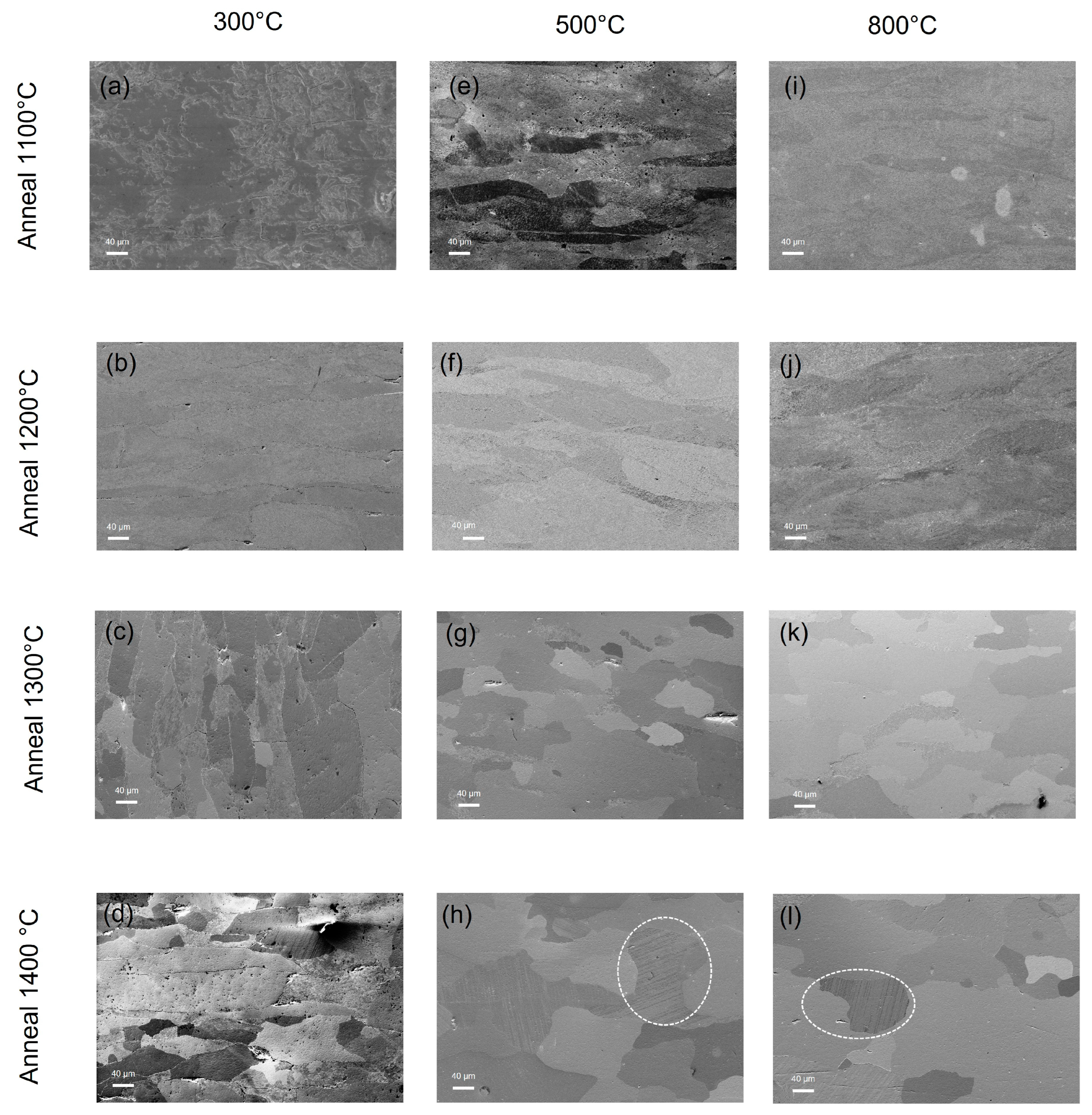

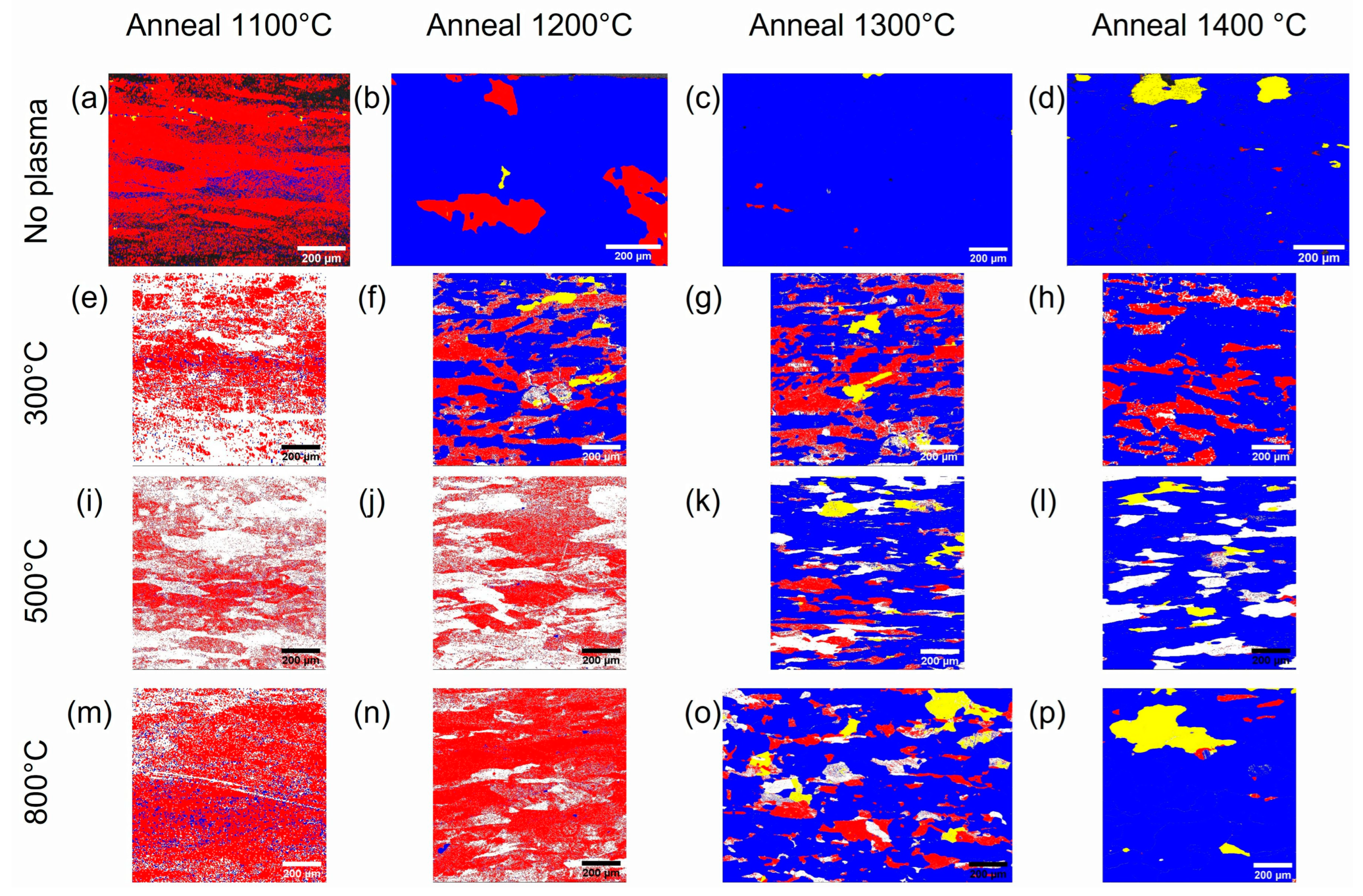
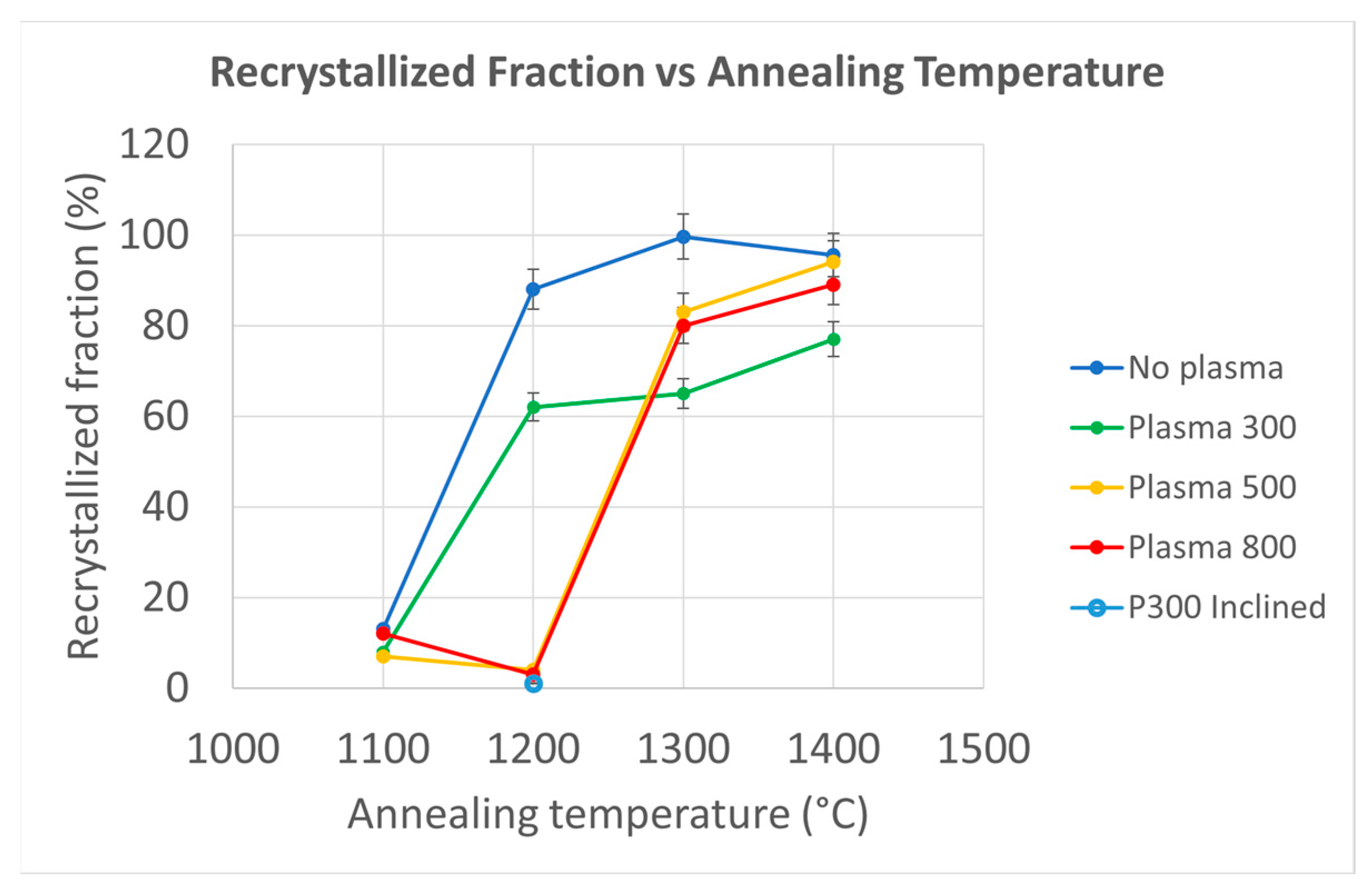

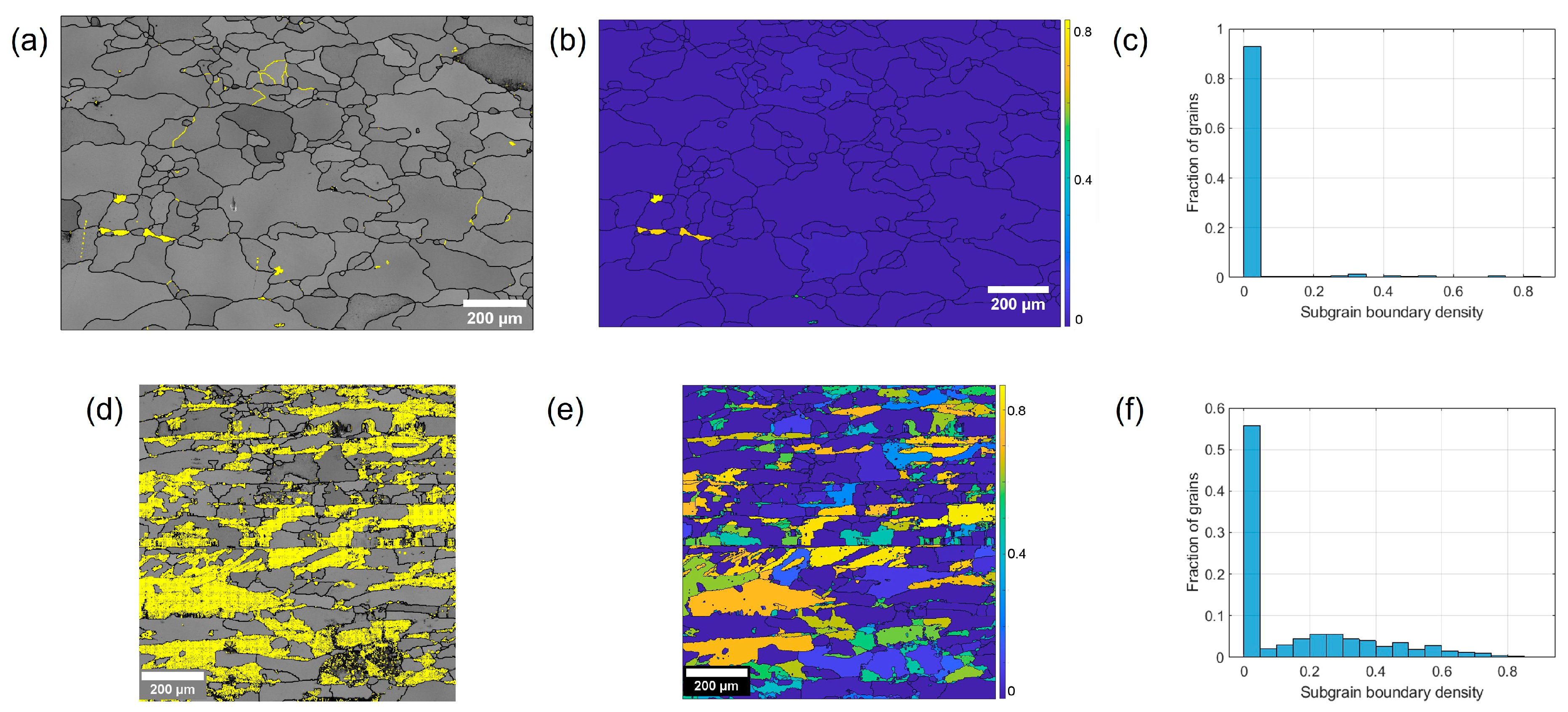
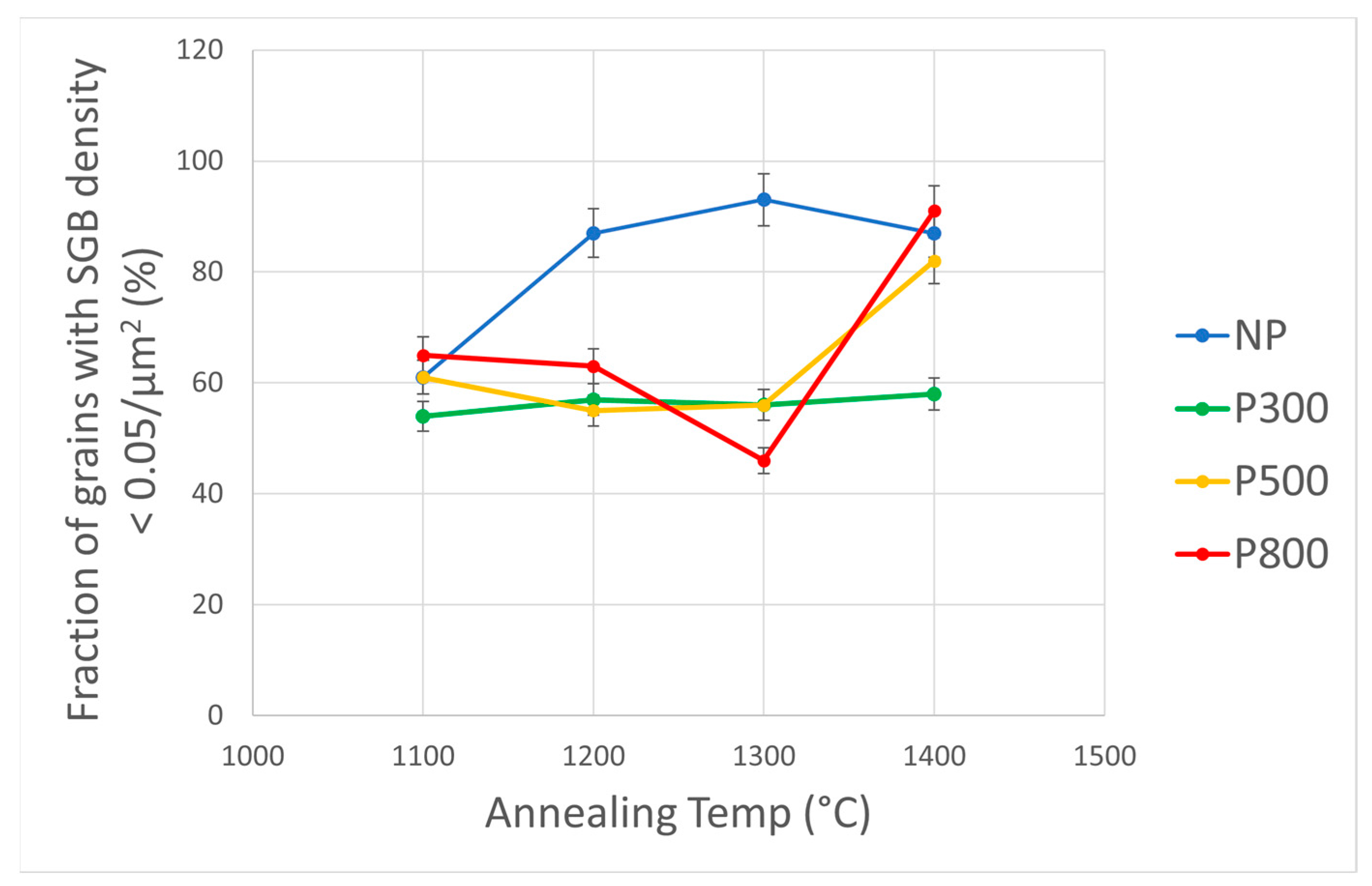
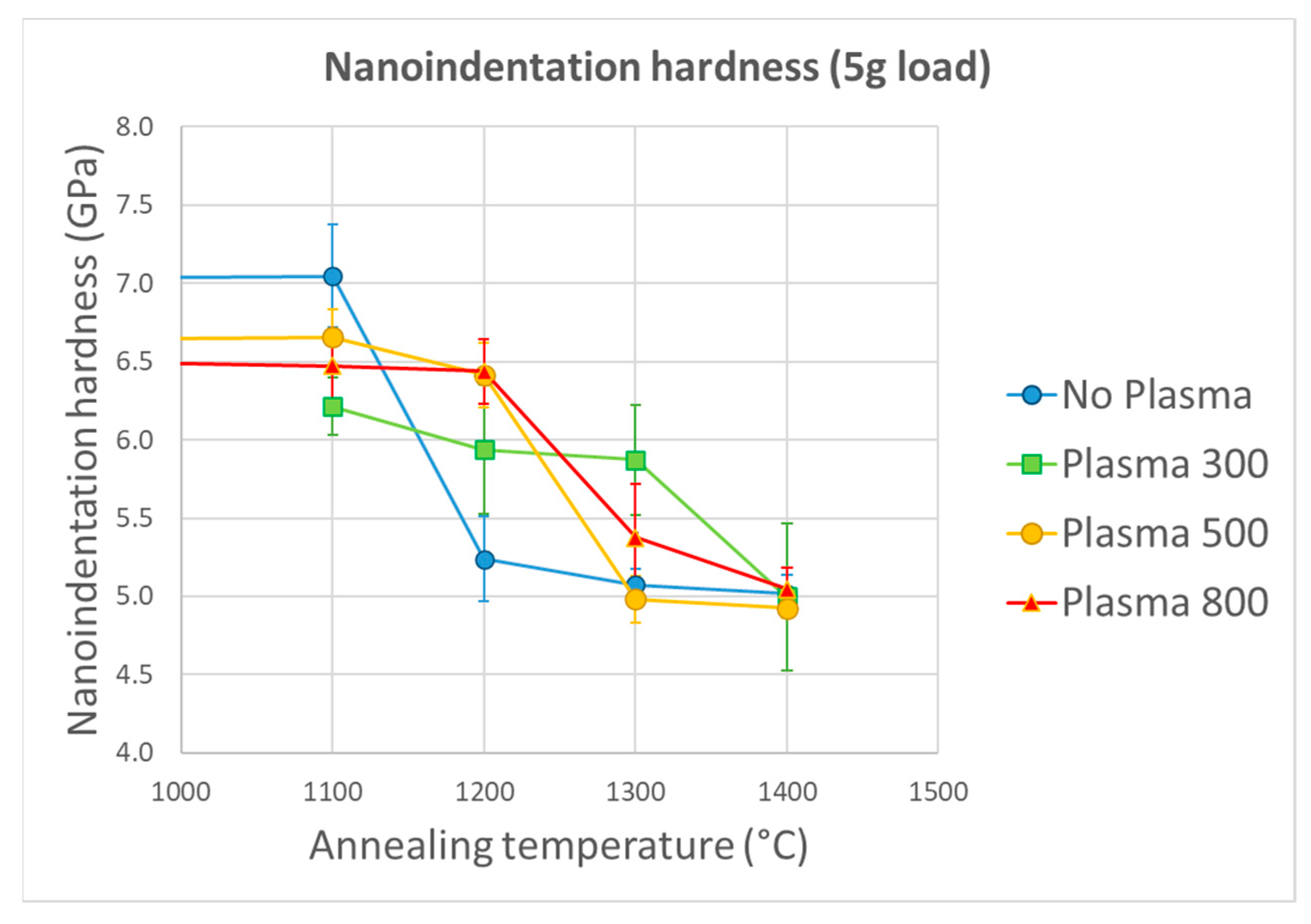
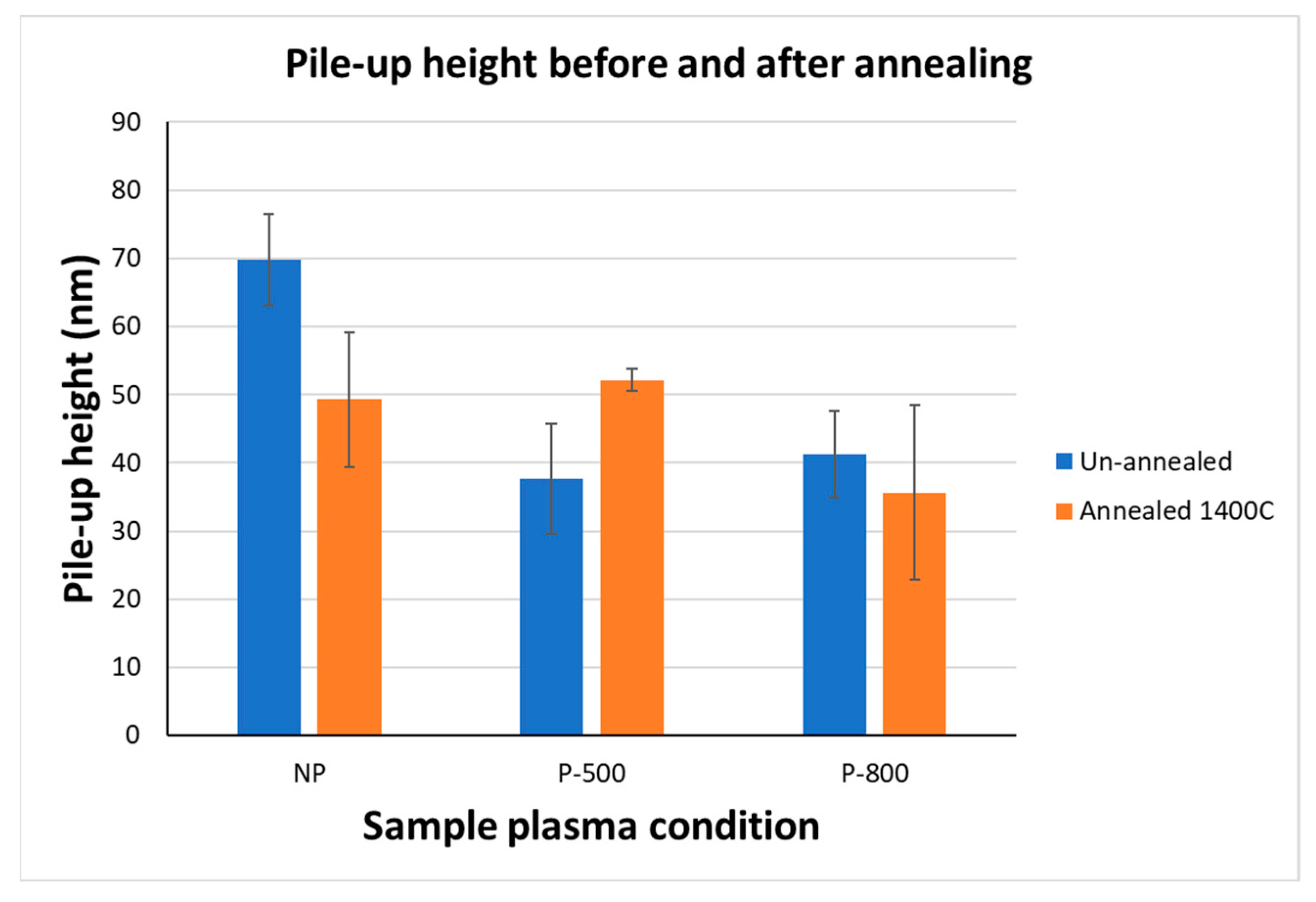
| Sample Name | Plasma Time/min | Plasma Temperature/°C | Annealing Temperature/°C | Ref. Name |
|---|---|---|---|---|
| W016 | 120 | 300 | - | P300ANil |
| W017 | 120 | 300 | 1100 | P300A1100 |
| W020 | 120 | 300 | 1200 | P300A1200 |
| W018 | 120 | 300 | 1300 | P300A1300 |
| W019 | 120 | 300 | 1400 | P300A1400 |
| W021 | 120 | 500 | - | P500ANil |
| W022 | 120 | 500 | 1100 | P500A1100 |
| W025 | 120 | 500 | 1200 | P500A1200 |
| W023 | 120 | 500 | 1300 | P500A1300 |
| W024 | 120 | 500 | 1400 | P500A1400 |
| W026 | 120 | 800 | - | P800ANil |
| W027 | 120 | 800 | 1100 | P800A1100 |
| W030 | 120 | 800 | 1200 | P800A1200 |
| W028 | 120 | 800 | 1300 | P800A1300 |
| W029 | 120 | 800 | 1400 | P800A1400 |
| Reference Samples | ||||
| W046 | - | - | - | PNilANil |
| W047 | - | - | 1100 | PNilA1100 |
| W048 | - | - | 1200 | PNilA1200 |
| W049 | - | - | 1300 | PNilA1300 |
| W050 | - | - | 1400 | PNilA1400 |
Disclaimer/Publisher’s Note: The statements, opinions and data contained in all publications are solely those of the individual author(s) and contributor(s) and not of MDPI and/or the editor(s). MDPI and/or the editor(s) disclaim responsibility for any injury to people or property resulting from any ideas, methods, instructions or products referred to in the content. |
© 2023 by the authors. Licensee MDPI, Basel, Switzerland. This article is an open access article distributed under the terms and conditions of the Creative Commons Attribution (CC BY) license (https://creativecommons.org/licenses/by/4.0/).
Share and Cite
Bhattacharyya, D.; Thompson, M.; Hoang, C.; Koshy, P.; Corr, C. Effect of He Plasma Exposure on Recrystallization Behaviour and Mechanical Properties of Exposed W Surfaces—An EBSD and Nanoindentation Study. Metals 2023, 13, 1582. https://doi.org/10.3390/met13091582
Bhattacharyya D, Thompson M, Hoang C, Koshy P, Corr C. Effect of He Plasma Exposure on Recrystallization Behaviour and Mechanical Properties of Exposed W Surfaces—An EBSD and Nanoindentation Study. Metals. 2023; 13(9):1582. https://doi.org/10.3390/met13091582
Chicago/Turabian StyleBhattacharyya, Dhriti, Matt Thompson, Calvin Hoang, Pramod Koshy, and Cormac Corr. 2023. "Effect of He Plasma Exposure on Recrystallization Behaviour and Mechanical Properties of Exposed W Surfaces—An EBSD and Nanoindentation Study" Metals 13, no. 9: 1582. https://doi.org/10.3390/met13091582
APA StyleBhattacharyya, D., Thompson, M., Hoang, C., Koshy, P., & Corr, C. (2023). Effect of He Plasma Exposure on Recrystallization Behaviour and Mechanical Properties of Exposed W Surfaces—An EBSD and Nanoindentation Study. Metals, 13(9), 1582. https://doi.org/10.3390/met13091582







